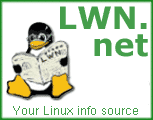
Summary page
Return to the Kernel page
Recent Features
LWN.net Weekly Edition for March 18, 2004
LWN.net Weekly Edition for March 11, 2004
The annotated SCO stock price chart
A grumpy editor's calendar search
|
Examining a kobject hierarchy |
At the root of the block subsystem hierarchy is a subsystem called
block_subsys; it is defined in drivers/block/genhd.c. As
you'll recall from The Zen of Kobjects, a
Each kset contains its own kobject, and block_subsys is no exception. In this case, the kobject's parent field is explicitly set to NULL (indicated by the ground symbol in the picture). As a result, this kobject will be represented in the top level of the sysfs hierarchy; it is the kobject which lurks behind /sys/block.
![[Subsystem and disks]](disks-on.png)
Things do not end there, however; a gendisk structure is a complicated
thing. It contains, among other things, an array of partition entries (of
type struct hd_struct),
each of which has embedded within it, yes, a kobject. The parent of each
As you can see, the kobject type of a partition is ktype_part. This type implements the attributes you will see in the sysfs entries for each partition, including the starting block number and size.
The request queue and I/O scheduler information in sysfs is currently
read-only. There is no reason, however, why sysfs attributes could not be
used to change I/O scheduling parameters on the fly. The selectable I/O scheduler patch uses sysfs
attributes to change I/O schedulers completely, for example.
Putting it all together![[The full diagram]](block-ko.png) So far, we have seen a number of disconnected pieces. The full diagram can
be found on this page; it
is a bit wide to be placed inline with the text (a small, illegible
version appears to the right). Also on that page, you'll
find a corresponding diagram showing the sysfs names the correspond to each
kobject.
So far, we have seen a number of disconnected pieces. The full diagram can
be found on this page; it
is a bit wide to be placed inline with the text (a small, illegible
version appears to the right). Also on that page, you'll
find a corresponding diagram showing the sysfs names the correspond to each
kobject.
The data structure as described is the full implementation of the /sys/block subtree of sysfs. The full sysfs tree contains rather more than this, of course. For each gendisk which shows up under /sys/block, there will be a separate entry under /sys/devices which describes the underlying hardware. Internally, the link between the two is contained in the driverfs_dev field of the gendisk structure. In sysfs, that link is represented as a symbolic link between the two sub-trees. Hopefully this series of pictures helps in the visualization of a portion of the sysfs tree and the device model data structure that implements it. The device model brings a great deal of apparent complexity, but, once the underlying concepts are grasped, the whole thing is approachable. Post a comment
|
![[Block subsystem]](block-su.png) subsystem is a very simple structure, consisting of a semaphore and a
kset. The kset will define, in its ktype field, what type of
kobjects it will contain; for block_subsys, this field is set to
ktype_block. Pictorially, we can show this structure as seen on
the right.
subsystem is a very simple structure, consisting of a semaphore and a
kset. The kset will define, in its ktype field, what type of
kobjects it will contain; for block_subsys, this field is set to
ktype_block. Pictorially, we can show this structure as seen on
the right.
![[Disk symbol]](disk-box.png) A block subsystem is not very interesting without disks. In the block
hierarchy, disks are defined by a struct gendisk, which can be
found in <include/linux/genhd.h>. The gendisk interface is
described in
A block subsystem is not very interesting without disks. In the block
hierarchy, disks are defined by a struct gendisk, which can be
found in <include/linux/genhd.h>. The gendisk interface is
described in ![[Partitions]](partitio.png) partition is the disk which contains it. It would have been possible to
implement the list of partitions as a kset, but things weren't done that
way. Partitions are a relatively static item, and their ordering matters,
so they were done as a simple array. We depict that array as seen on the
right.
partition is the disk which contains it. It would have been possible to
implement the list of partitions as a kset, but things weren't done that
way. Partitions are a relatively static item, and their ordering matters,
so they were done as a simple array. We depict that array as seen on the
right.
![[I/O request queue]](iorq0000.png) Another item associated with each gendisk is its I/O request queue. The
queue, too, contains a kobject (of type queue_ktype) whose parent
is the associated gendisk. The I/O scheduler ("elevator") in use with an
I/O request queue is also represented in the hierarchy. The scheduler's
kobject's type depends on which scheduler is being used; the (default)
anticipatory scheduler uses as_ktype. The resulting piece of the
puzzle looks as portrayed on the left.
Another item associated with each gendisk is its I/O request queue. The
queue, too, contains a kobject (of type queue_ktype) whose parent
is the associated gendisk. The I/O scheduler ("elevator") in use with an
I/O request queue is also represented in the hierarchy. The scheduler's
kobject's type depends on which scheduler is being used; the (default)
anticipatory scheduler uses as_ktype. The resulting piece of the
puzzle looks as portrayed on the left.